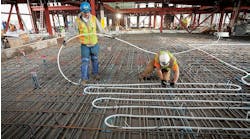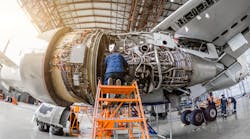Latest from Best Practices
Sponsored
If you are a pilot or have worked around airplanes, you might be familiar with an A&P Mechanic. This is an individual who holds an airframe and/or powerplant (A&P) certificate which is issued by the Federal Aviation Administration (FAA). These technicians inspect aircraft as well as conduct preventative maintenance and repairs.
An A&P mechanic works under a strict code of conduct and must abide by detailed regulations. They are ultimately responsible for judging the airworthiness of the plane and will ground that plane if needed.
For an A&P, the idea is to avoid making repairs. In the HVAC industry, we often refer to that work as “demand service.” The real goal of an A&P is to conduct high level preventative maintenance. They need to replace components before they fail, since failure can result in the loss of the plane and all the passengers.
HVAC technicians must think like A&Ps with respect to preventative maintenance. It is impressive when a person can determine that a component has failed and knows how to replace it. It is far more impressive when a technician can detect an imminent failure and replace that component before it fails. That is what separates “parts changers” from “technicians”.
Technicians must carry the proper tools and have easy access to a full range of parts and supplies. It is vital to have certain diagnostic tools and understand how to use them.
Truck Stocking for Success
It is important that technicians have quick access to the parts and supplies needed to perform quality work. If the technician does not have the items they need, they will be tempted to take shortcuts. This is not good for the client, and it will hurt the company’s revenue. I have written a lot on this topic and invite you to search for my other articles on truck stocking and replenishment.
Acquire the Proper Tools
To be a top-level HVAC technician, you need to have at least the following diagnostic tools: Anemometer, wet bulb/dry bulb digital thermometer, digital refrigerant gauges with remote temperature sensors, combustion analyzer, carbon monoxide detector, digital manometer, air quality analyzer, megohmmeter, and a high-quality true RMS multi-meter. If your multi-meter cannot measure actual capacitance, acquire a dedicated capacitor tester.
Identifying Code Violations
Service technicians need to be familiar with all local and national codes related to their job. They must also pay attention to the manufacturer’s installation and maintenance guidelines. Do not be afraid to “Red-Tag” the appliance. After all, an airplane mechanic certainly would.
Always Start with Airflow
When it comes to HVAC, nothing matters until we have complete and proper airflow across the evaporator coil and condensing coil. Always begin your diagnostics or maintenance by making sure that all coils and fan blades are clean. Inspect the ductwork and verify that the static pressure is within acceptable ranges. Verify that there is proper airflow and address any airflow issues before doing anything else.
Electrical Component Replacement
Replace any component with silver coated contact that shows signs of pitting or corrosion. This includes switches, relays and especially contactors.
Replace any terminal or electrical connection that shows signs of high heat, corrosion, pitting, or wear. Don’t forget to inspect compressor terminals, fuse boxes, and breaker seats. Replace fuses and fuse links that appear to be in poor condition.
Replace any motor that shows clear signs of high continued operating temperatures. Replace any motor or pump whose bearings indicate signs of wear or unacceptable mechanical ‘play.’
Open the breaker panels and side panels (if allowed). Verify correct wire-breaker size. Verify one conductor per breaker. Tighten all electrical connections. Inspect seats. Verify proper grounding. Verify that the furnace and A/C have their own dedicated circuit. Inspect breaker switches for signs of high heat. Replace breakers that are suspected of being ‘weak,’ especially when they are more than ten years old.
Carefully inspect and test all other related electrical systems and ALWAYS seek permission before replacing parts.
Produce Professional Documentation
Because of the seriousness of their work, the A&P is expected to maintain professional level documentation. The work of an HVAC technician is just as serious, and the technician’s paperwork should reflect that fact. Document everything that you did. Include your recommendations and classify them as “Required” and “Highly Recommended.” If your recommendations are not accepted, document that fact.
Here is an example. Your required recommendation is to add refrigerant. This action is required to get the heat-pump working. Your highly recommended task is to locate and repair the leak. If they decline, there will likely be a call-back. You will document the fact that refrigerant will likely continue to leak, resulting in additional service calls and fees.
Defining Your Service Level
There are generally four types of people that perform service calls. They are Parts Changers, Troubleshooters, Technicians, and Master Technicians (Master Mechanics). Few service people are true technicians. Until they think and act like an airplane mechanic, they will simply be a parts changer or a troubleshooter.
Approach your work like aviation maintenance, with seriousness and diligence, recognizing that lives and safety depend on you. Use only accepted/approved methods, techniques, and practices to perform maintenance or other authorized tasks.
If you find yourself riding on an airplane, you should hope that it has been maintained by good A&Ps. If they do not do their jobs, people can and have died. The same is true for HVAC technicians.
Mastering service operations management can be a leading factor in setting your contracting business apart from its competitors. To learn on the subject, including to start a free trial to dive deep into detailed training materials, visit MyContractorUniversity.com/CBS.
James Leichter is a longtime HVAC contractor, consultant, and public speaker. Leichter is president and CEO at Aptora Corporation, a maker of contracting business management software. He is the editor of MrHVAC.com. James is a partner at RA Tax and Accounting, Inc. James is a founding faculty member at EGIA Contractor University. Learn more about EGIA and Contractor University.
James Leichter | CEO
James Leichter is a longtime HVAC contractor, consultant, and public speaker. He is president and CEO at Aptora Corporation, a maker of contracting business management software. Leichter is the editor of blackbeltcontracting.com and a founding faculty member of EGIA Contractor University (EGIA.org/University).


